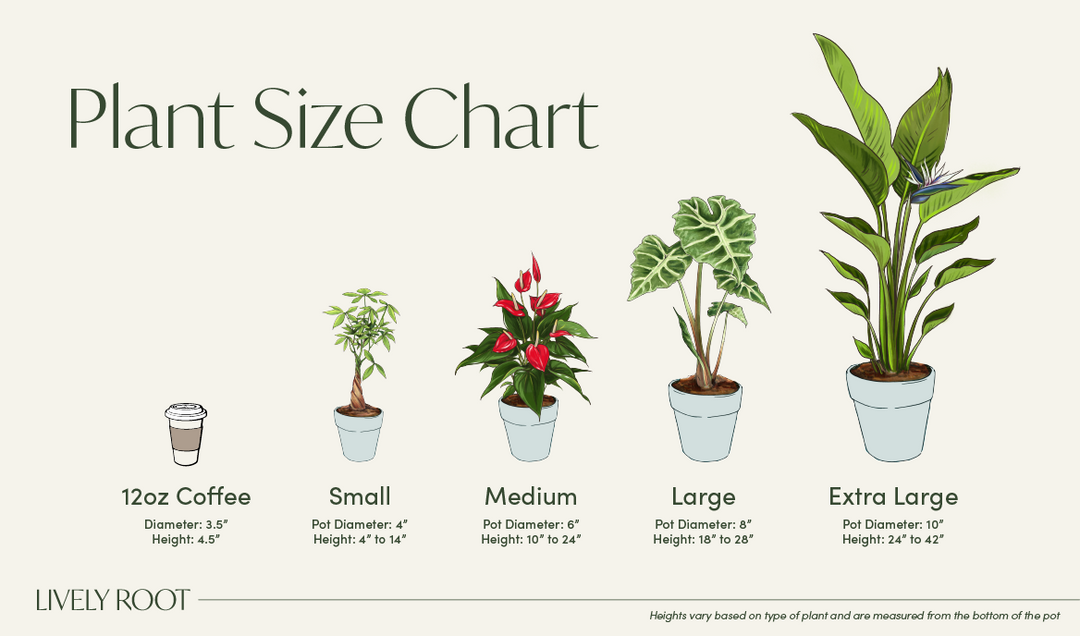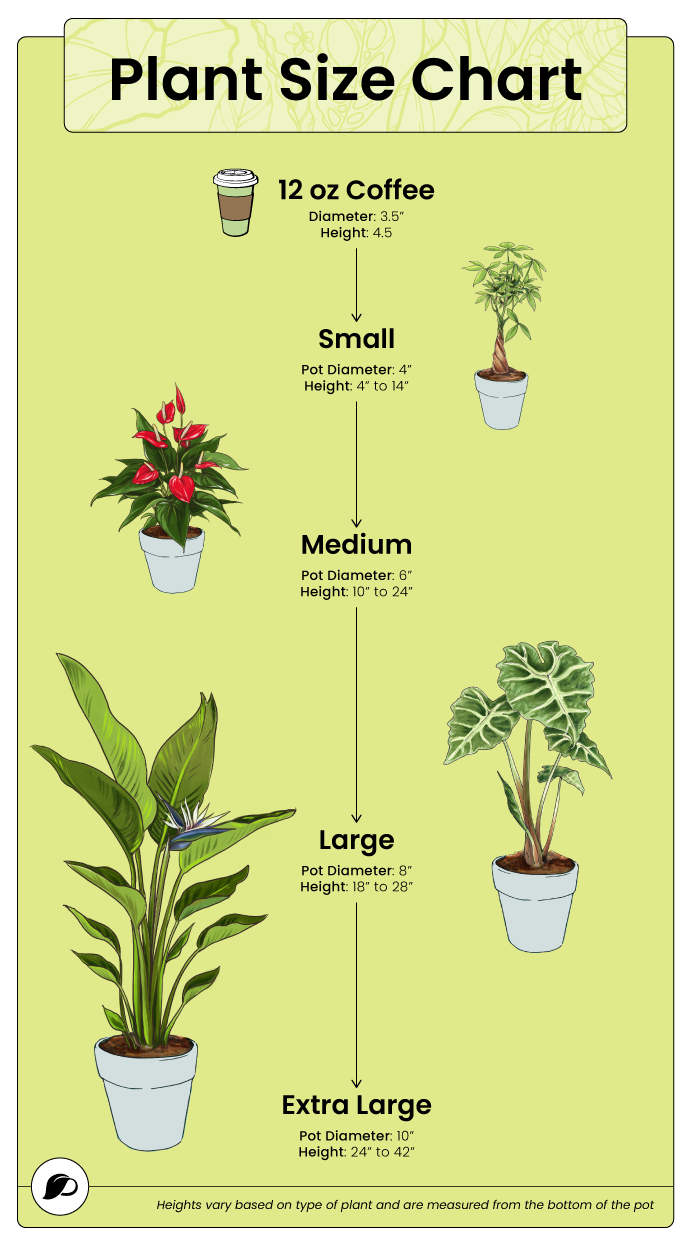Prefers medium levels of indirect light.
Areca Palm Care Guide & Presentation

Areca Palm for Sale Overview
The Areca Palm, scientifically known as Dypsis lutescens, belongs to the Arecaceae family. Originating from Madagascar, it thrives in USDA growing zones 10 to 11. It boasts vibrant-green soft, arching fronds and has a unique aesthetic appeal.
This palm can reach impressive heights of up to 6 to 7 feet in a container, so allow some space for it to thrive indoors. In warmer regions, it can make the perfect porch plant.
Areca palms prefer indirect sunlight and require easy to moderate care. They have a lifespan of approximately 10 years. According to Feng Shui, the Areca Palm tree symbolizes peace and prosperity. So, you can bring abundance and positive vibes to your home with this gorgeous palm tree.
Areca Palm Tree Benefits
The Areca Palm Tree offers a plethora of advantages beyond its aesthetic charm. With its graceful fronds and tropical allure, this plant enhances indoor spaces while providing numerous benefits.
- Increases indoor humidity levels by releasing moisture into the air
- Acts as a natural air purifier
- Adds a tropical touch to interior decor
- Enhances relaxation and reduces stress
- Requires minimal maintenance
Areca Palm Tree: Alternative Names
- Butterfly Palm
- Cane Palm
- Madagascar Palm
- Golden Feather Palm
- Yellow Palm
Indoor Areca Palm Care Guide
Embrace the low-maintenance nature of the indoor Areca Palm with the following simple Areca Palm care instructions. This plant thrives with little attention, making it an excellent choice for novice and experienced plant enthusiasts.
Light and Temperature
Place Areca Palms in a location with bright, indirect sunlight. To mimic its natural tropical habitat, ensure the temperature remains consistent between 65-75°F (18-24°C).
Watering and Humidity
Water sufficiently but allow the soil to dry completely between watering sessions. Occasionally mist the leaves or place a humidifier nearby to maintain humidity levels.
Soil and Repotting
Use well-draining potting soil and repot your indoor Areca Palm every 2-3 years to refresh the soil and provide ample space for root growth.
Feeding and Pruning
Feed your palm with a balanced liquid fertilizer monthly during the growing season. Prune any yellow or brown fronds regularly to maintain its vibrant appearance.
Common Issues
Watch for signs of overwatering, such as yellowing leaves or soggy soil, and adjust watering accordingly. Additionally, pests like spider mites or scale insects should be monitored and treated promptly if detected.
Areca Palm: Placement, Companion & Alternative Plants
Enhance your indoor oasis with the majestic Areca Palm by considering its ideal placement, suitable companion plants, and alternative options. Let’s explore how to maximize the beauty and benefits of this tropical gem in your space.
Best Locations & Uses
- Ideal for spaces with bright, indirect light, such as living rooms, near windows with sheer curtains.
- Adds a tropical touch to offices or workspaces, thriving in fluorescent lighting conditions.
- Perfect for bedrooms, contributing to a serene atmosphere conducive to relaxation and sleep.
- Enhances the aesthetics of spacious bathrooms with its lush foliage and ability to thrive in high humidity.
- Well-suited for beginners and those with busy lifestyles due to its low-maintenance nature and resilience to occasional neglect.
Companion Plants
Enhance the beauty of your indoor space by pairing the Areca Palm with one or more of the following companion plants:
- Peace Lily (Spathiphyllum spp.): Known for its air-purifying qualities, the Peace Lily thrives in low-light conditions, making it an ideal companion for the Areca Palm in areas with limited sunlight.
- Snake Plant (Sansevieria spp.): With its striking vertical growth and low-maintenance nature, the Snake Plant complements the lush, feathery foliage of the Areca Palm, creating an eye-catching display.
- Spider Plant (Chlorophytum comosum): The Spider Plant’s cascading foliage adds visual interest and texture to your indoor plant arrangement, while its easy-care requirements make it a perfect match for the Areca Plant in any interior setting.
Alternative Plants
Consider the following alternative plants, available on Lively Root, as substitutes for the Areca Palm plant:
- Pygmy Date Palm Tree: (Phoenix roebelenii): The Pigmy Date Palm brings tropical vibes to any space. As their name suggests they are small, but if you look after it well, you can expect it to reach heights of six to twelve feet. They originally come from Southeast Asia, so if you live in a USDA Zone 10-11, it can thrive on your patio.
- Neanthe Bella Palm: (Chamaedorea elegans): The Neanthe Bella Palm, also known as the Parlor Palm, is compact and easy to care for, making it ideal for busy folks or those new to plant parenting. It is renowned for its resilience, so it thrives well in various environments.
- Dwarf Cavendish Banana Tree (Musa acuminata): Bring a touch of the tropics into your home with a broad-leafed banana tree. It requires excellent drainage, whether growing it in a pot or planted in the ground. It is a dwarf varietal but can grow upwards to 6 feet tall. This banana tree will produce fruit once per tree once it is 2-3 years old.
Get a Gorgeous Areca Palm From LivelyRoot Today
Transform your space with the vibrant presence of an Areca Palm from Lively Root. Elevate your indoor oasis with this elegant and pet-friendly plant that adds a touch of tropical sophistication to any room.
Customer Reviews
Follow us @livelyroot & show us your #livelyroot plants

